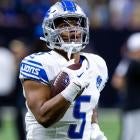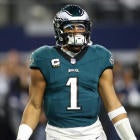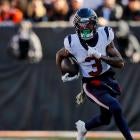If you've listened to Fantasy Football Today over the past year, there's a decent chance you've heard me use the phrase "age-adjusted production" when describing wide receivers. What you probably haven't heard me do a lot is explain what that actually means, and if you're unfamiliar with the concept, there's a valid question that follows.
What specifically are you looking at to determine if a player had good or bad age-adjusted production?
That's a question I want to dive into here, and to do so I've enlisted the help of Shawn Siegele, an owner at RotoViz (a site I wrote at for two-and-a-half years, full disclosure). Shawn is perhaps most well-known for coining the term "Zero RB" while writing his original 2013 piece on the misunderstood draft strategy that has died a thousand deaths, but I'd argue his pioneering research on prospect evaluation is his finest work.
With Frank DuPont and Jon Moore, Shawn was integral in the development of concepts like market share, dominator rating and of course breakout age, which he originally wrote about in 2014. In the years since, I've watched as these concepts have slowly gained popularity.
With wide receiver combine testing coming Thursday night, it's very much worth discussing the origins of these stats, how to measure them, what they tell us … and the all-important question of why? Why are these stats so effective at determining hits and misses? What is it about the way things are done in the NFL that creates this phenomenon?
Some background
A stats vs. film battle flares up every year around this time, and yet, here in February 2020, Benjamin Solak of the scouting website The Draft Network wrote a piece titled, "Breakout Age Is Nothing To Be Afraid Of." Solak's piece is excellent and well worth a read, though breakout age has been around longer and is likely even more valuable than he suggests.
As I noted, Shawn introduced this concept in 2014, which — as far as new-age stats go — makes it practically ancient. By comparison, breakout age is twice as old as Josh Hermsmeyer's initial work on air yards that brought that stat to the forefront. So why has it taken so long for breakout age to catch on?
Well, there is and has been some confusion around the metric, specifically around how it's measured. Shawn's initial work referenced a 30% dominator rating — measured as the average share of a team's receiving yardage and touchdowns a wide receiver achieved in a given season — while PlayerProfiler, a site with great … player profiles … where you can research these stats, uses a 20% cutoff.
Blair Andrews, managing editor of RotoViz and author of an excellent series of innovative work called The Wrong Read, dove into this recently and found that the original method is probably the best, but that still others also return good results. He also demonstrated the big advantage in Fantasy scoring when you compare early breakouts to later breakouts with the same draft position.
While sharing more recent research from Peter Howard and Anthony Amico — each building off Shawn's work but using different cutoffs reflecting their respective backgrounds at PlayerProfiler and RotoViz — Solak correctly notes the specific cutoff isn't as important as the evidence there's something powerful here. Scott Barrett looked at this a different way at PFF, using their player grades and finding similar predictive qualities.
All the evidence is very clear — the more productive a player was early in his college career, the better.
One commonality between the above stats is controlling for team volume to talk about production. That's true of the various market share or dominator rating metrics, as well as others. Blair has done significant research into these stats and recently released a correlation matrix that notes yards per team pass attempt — a stat not surprisingly used in Football-Outsiders' Playmaker Score — also correlates well with future NFL production.
Regardless of the metric, when the term age-adjusted production comes up, it's typically in reference to team-controlled production at an early age. And while research into the stat has evolved in a way that can make the specifics confusing to follow or reference, these stats exist on a spectrum. Whether a player hit a breakout threshold is important to define for research purposes, but when evaluating a single prospect we can talk about his exact numbers.
Put simply, we're asking this question: Did the player produce at an early age?
Enough already, let's talk to Shawn
As much as I've discussed all these stats, nothing predicts future success like draft position, which Shawn is always quick to note:
"When you talk about experience/age-adjusted production and team-adjusted production, you're looking for an advantage that will help you beat draft position alone" Siegele explains. "A receiver's draft position accounts for a variety of factors – raw production, perceived talent, tested athleticism – in a way that also gives a key insight into opportunity. The team is telling you how good they think the player is and how much opportunity they'll give him over the first several years."
Setting aside all sorts of stat or film discussions on prospect success, you'd do well to simply look at how high a player was drafted and use that as a ranking system of sorts. All else being equal, after an NFL team invests a high pick in a player, they will give him more chances to be successful than another player. Just look at Laquon Treadwell.
But as Shawn notes, age-adjusted production is perhaps our best tool for beating draft position.
"To locate players who will overperform draft position and avoid underperformers, we have to look at elements that aren't fully considered (or even overdrafted, like athleticism)," he said. "Making a team adjustment can help. How much of the passing offense did the receiver generate? To give an example from the current class, Henry Ruggs and Laviska Shenault both came in around 750 receiving yards, pedestrian numbers for projected first-round picks. But Shenault represented 30% of his team's receiving yardage – a "rule of thumb" level for eventual NFL success – while Ruggs managed only 18%."
There's that market share of yards metric, and what it's saying is that Shenault's production came in an offense that wasn't otherwise very good throwing the ball. Think 750 yards with more defensive attention and worse quarterback play.
But Shawn also notes how athleticism is overvalued, and that gets back to my earlier question of why these production metrics are so effective?
Every Sunday, we see players win on the strength of their athleticism alone. But what the data is telling us is athleticism alone doesn't equate to production, and that if a player does win based on their athleticism, that is likely to have shown up in their production at the collegiate level.
Julio Jones is a physical specimen, and his athleticism absolutely matters. But his athleticism also helped him produce fantastic numbers at the college level. It's not that his athleticism doesn't matter — it's that it's already accounted for. It takes more than just athleticism to be a great receiver.
Take Keenan Allen, one of the highlighted players in Shawn's initial piece on breakout age. Allen was great from Day 1 at Cal, and out-produced teammate and future NFL player Marvin Jones over two years when Allen was a true freshman and sophomore and Jones was a junior and senior. Even two years younger, and with far less measured athleticism — Allen ran a 4.71 to Jones' 4.46 — Allen was the more productive player when the two shared a field.
Allen has continued that production at the NFL level, because he doesn't win on his athleticism — or at least not in the ways we traditionally measure it. His route running has become the stuff of legend, and while that doesn't show up in a 40 time, his ability to get open play after play — a consistency that trumps the type of highlight play someone like Jones is capable of making — allows him to repeatedly win against even the best defensive backs in the world.
This concept that athleticism is overvalued at the wide receiver position has been studied and proven in several ways. In 2015, the Harvard Sports Analysis Collective studied the predictiveness of combine results against future NFL success, and found essentially no correlation to wide receiver success for any of the testable metrics.
My favorite research was from 2016, when Kevin Cole, now with PFF but at the time writing for RotoViz, found while creating a decision tree that attempted to bucket receivers into more successful and less successful groups that the algorithm didn't choose a single athletic metric for any of the decision nodes, in a piece he appropriately titled, "Collegiate Wide Receiver Production Isn't Everything, It's the Only Thing."
And when we control for draft position, what Shawn noted becomes clear — combine drills are actually overvalued. We run the risk of double counting when a prospect we like tests well, because the statistics already tell us how well a player uses that athleticism.
But NFL teams covet athletic ability, and for most other positions that has proven to be a useful guiding principle. At wide receiver, it's just not, at least not nearly to the degree NFL teams emphasize it in the draft. Teams overdraft athleticism relative to production, which opens the door for us.
And there's one more major one from Shawn that, having the luxury of knowing him, I know he's emphasized more in recent years.
"Understanding when the production occurs is also crucial. We see this in terms of both age and experience. Think of that 30% level. The younger a player is when he first hits this "draftable" level, the better he translates to the NFL. You can also think of it in terms of experience. Receivers who declare after only three seasons vastly outperform their senior counterparts," Siegele said. "For a fantasy owner, this translates into points. During the first three years of their NFL careers, both early breakouts and early declares perform at a similar level to later breakouts/seniors drafted a full round earlier. Given the expected values for different draft rounds, this creates appealing bargains in Rounds 2 and 3."
Simply whether a player declares early for the NFL or exhausts his full eligibility is an important differentiator. And as Shawn notes, that creates buying opportunities in rookie drafts and early into players' careers.
"Stefon Diggs, Tyler Boyd, and D.J. Moore are recent examples of undervalued prospects from different areas of the reality draft," he. said. "These receivers didn't post video game numbers in college – Boyd was the closest – but they all broke out before age 20 and declared early. Each of them finished with a career yardage share above 30% with at least one season above 40%. Receivers who hit both of those thresholds tend to become impact players."
And there it is, the entire concept of age-adjusted production wrapped up into a few sentences. You might recall my love for Moore last offseason, and if you're a podcast listener you're certainly aware of why I'm so high on A.J. Brown, who RotoViz had ranked as their No. 2 pre-draft rookie last year.
In today's FFT episode, I said I'd take both Moore and Brown in the first round of a Dynasty startup, because I don't consider their early-career production the extent of their profiles. What they did in college already gave them an incredible path to NFL success; that they've already hit on that just means in both cases you can acquire a young player before what is likely to be a long career of impressive performances.
Diggs is another player I remain high on, even considering his current passing game. He's shown an ability to produce both at a low average depth of target in 2018 and a high one in 2019, and essentially any role he's in he puts up numbers.
Diggs was also a fifth-round pick in the 2015 NFL draft, and is someone Shawn and anyone who considers these metrics loved from before he stepped on an NFL field. Two years later, Shawn wrote about an underdiscussed projected late-rounder by the name of Kenny Golladay before he lit up the combine and rose up prospect ranks. Golladay wound up going in the third round of the 2017 draft, but as we know, his tested athleticism mattered and matters to the extent that he knows how to consistently utilize it to produce on-field results. Even after his big combine, his going in the third round was a surprise to many observers, and whatever reason the Lions fell in love with him for, the higher draft slot meant the opportunity to produce early, and he's seized it.
Is this the only way to evaluate wide receivers? Of course not. But whether a player crushes the combine or not, they've already shown us plenty about their ability to use those tools for statistical success. Given what we already know about the strength of draft capital, those numbers are arguably the single best way to consistently beat the information the league gives us in April.
RotoViz's 2020 draft guide dives into this year's class from all of these angles, and I can't recommend it enough. It includes a piece from Shawn titled "The Bottom Line on Wide Receiver Breakouts and Breakout Age," as well as contributions from Curtis Patrick, Blair Andrews, T.J. Calkins and Travis May — whose Adjusted Production Index offers yet another way to consider age-adjusted production for wide receivers. If you want to learn more about age-adjusted production for this year's class, that's the best place to start.






















